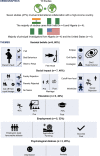The Impact of Social Stigma for Children with Cleft Lip and/or Palate in Low-resource Areas: A Systematic Review
- PMID: 31772907
- PMCID: PMC6846294
- DOI: 10.1097/GOX.0000000000002487
The Impact of Social Stigma for Children with Cleft Lip and/or Palate in Low-resource Areas: A Systematic Review
Abstract
There are still children with cleft lip and/or palate (CLP) in low-resource areas who face social rejection. This stigma disadvantages children in education, employment, marriage, and community, and is exacerbated by barriers to care. Our study objective was to conduct a systematic review of the impact of social stigma of CLP for children in low-resource areas. We followed the Preferred Reporting Items for Systematic Reviews and Meta-analyses guidelines. A systematic search was conducted of 3 databases: Ovid Embase, Ovid Medline, and the African Journal Online from 2000 to October 5 2018. Common themes were identified using a grounded theory approach and quantitatively summarized. The Joanna Briggs Institute criteria were used to evaluate the risk-of-bias assessments. Four hundred seventy-seven articles were screened; 15 articles were included that focused on the impact of social stigma on CLP in low-resource areas. This was limited to English articles. The majority of studies originated in Nigeria or India. Themes were reported as follows: societal beliefs (n = 9; 60%), social impact (n = 7; 46%), marriage (n = 7; 46%), education (n = 6; 40%), employment (n = 5; 33%), and psychological distress (n = 3; 20%). Causes include the effect of "God's will," supernatural forces, evil spirits or ancestral spirits, exposure to an eclipse, black magic, or a contagion. Further, children with CLP may not be worth a full name or considered human and killed. Awareness of the impact of social stigma for children with CLP in low-resource areas generates support toward national education and awareness in low-resource areas.
Copyright © 2019 The Authors. Published by Wolters Kluwer Health, Inc. on behalf of The American Society of Plastic Surgeons.
Figures





References
-
- Tanaka SA, Mahabir RC, Jupiter DC, et al. Updating the epidemiology of cleft lip with or without cleft palate. Plast Reconstr Surg. 2012;129:511e–518e. - PubMed
-
- Mossey PA, Little J, Munger RG, et al. Cleft lip and palate. Lancet. 2009;374:1773–1785. - PubMed
-
- Allori AC, Kelley T, Meara JG, et al. A standard set of outcome measures for the comprehensive appraisal of cleft care. Cleft Palate Craniofac J. 2017;54:540–554. - PubMed
-
- Yao CA, Swanson J, Chanson D, et al. Barriers to reconstructive surgery in low- and middle-income countries: a cross-sectional study of 453 cleft lip and cleft palate patients in Vietnam. Plast Reconstr Surg. 2016;138:887e–895e. - PubMed
-
- Fell MJ, Hoyle T, Abebe ME, et al. The impact of a single surgical intervention for patients with a cleft lip living in rural Ethiopia. J Plast Reconstr Aesthet Surg. 2014;67:1194–1200. - PubMed
LinkOut - more resources
Full Text Sources
Miscellaneous
